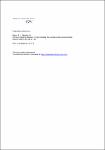Chronic wasting disease: Fingerprinting the culprit in risk assessments
Daus, Martin L.
Beekes, Michael
Transmissible spongiform encephalopathies (prion diseases) in animals may be associated with a zoonotic risk potential for humans as shown by the occurrence of variant Creutzfeldt-Jakob disease in the wake of the bovine spongiform encephalopathy epidemic. Thus, the increasing exposure of humans in North America to cervid prions of chronic wasting disease (CWD) in elk and deer has prompted comprehensive risk assessments. The susceptibility of humans to CWD infections is currently under investigation in different studies using macaques as primate models. The necessity for such studies was recently reinforced when disease-associated prion protein and its seeding activity were detected in muscles of clinically inconspicuous CWD-infected white-tailed deer (WTD). Increasing evidence points to the existence of different CWD strains, and CWD prions may also change or newly emerge over time. Therefore, CWD isolates examined in macaques should be characterized as precisely as possible for their molecular identity. On this basis other CWD field samples collected in the past, present or future could be systematically compared with macaque-tested inocula in order to assess whether they are covered by the ongoing risk assessments in primates. CWD typing by Fourier transform-infrared spectroscopy of pathological prion protein may provide a method of choice for this purpose.
Dateien zu dieser Publikation
Keine Lizenzangabe

